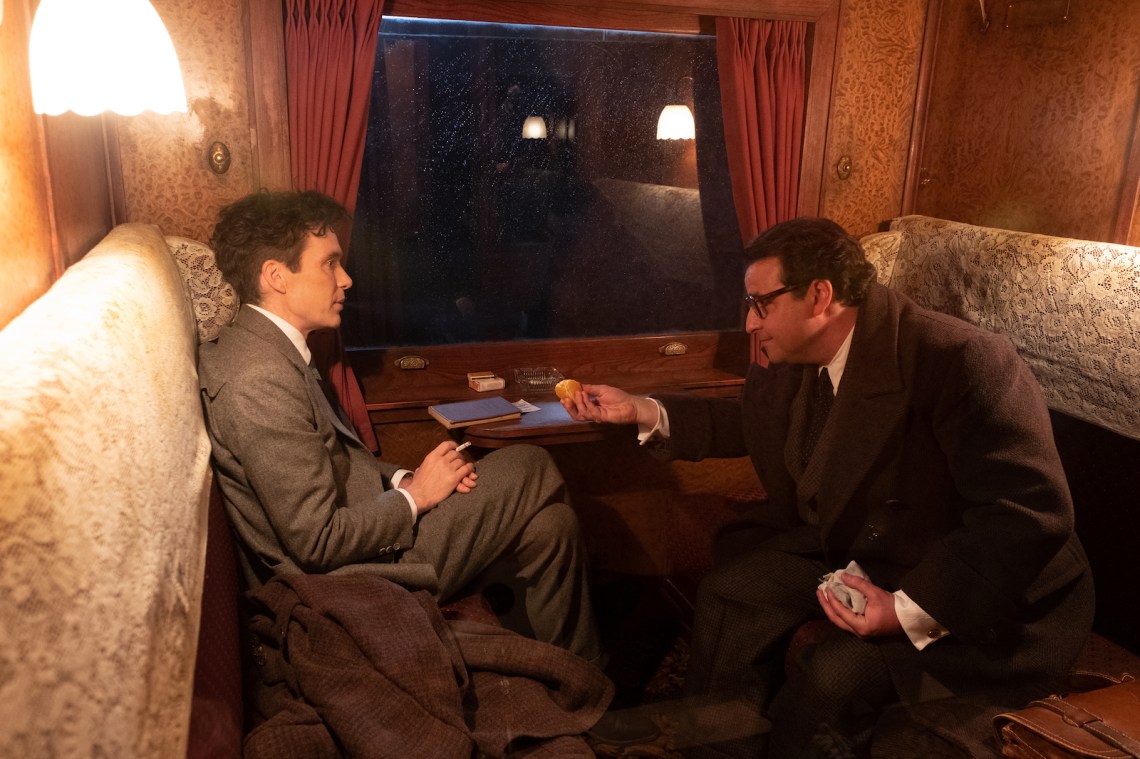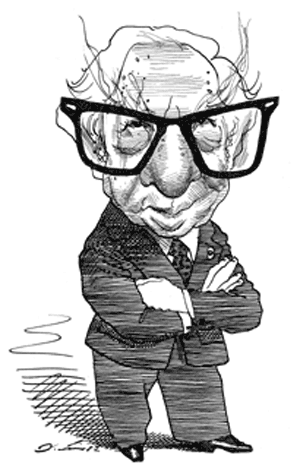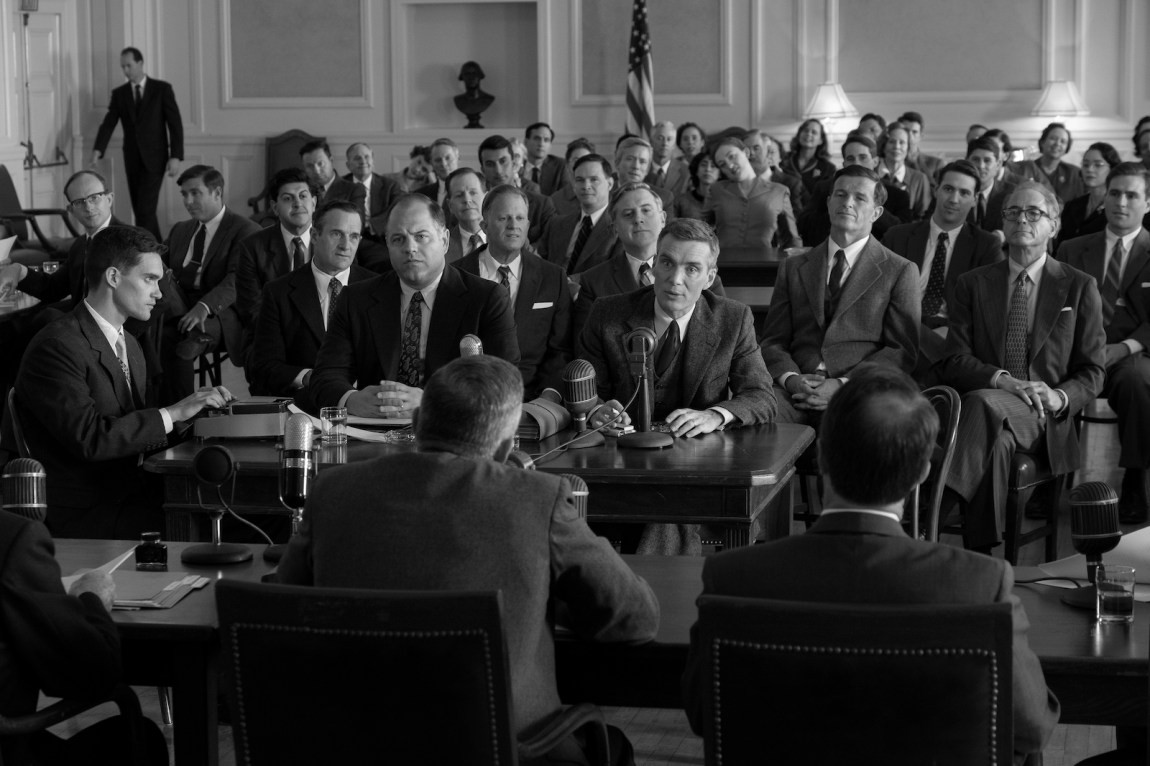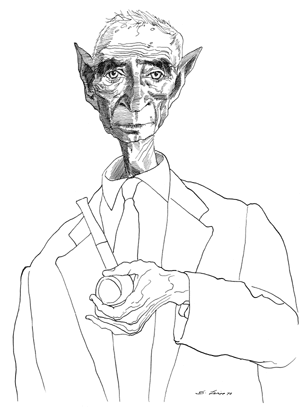If you’re a member of any dynasty prominent in twentieth-century political history—with Roosevelts, Churchills, Windsors, and Kennedys at the forefront—your relatives are certain to be reincarnated in a nondocumentary film sooner or later. The halo effect of those families’ global fame sometimes also encompasses lesser participants on the periphery of momentous events. So when I read that Christopher Nolan, the British-American director best known for his Dark Knight Batman trilogy, would make his next feature about the theoretical physicist J. Robert Oppenheimer, what excited me most was personal. Often called the father of the atomic bomb, Oppenheimer was a longstanding intimate and colleague of I. I. Rabi (rhymes with “hobby”), winner of the 1944 Nobel Prize in Physics and a first cousin of my paternal grandfather. To this day members of the Rabi branch of our Stammbaum, whom I call my nuclear family, still refer to the physicist by his nickname, Oppie.
I immediately flew to IMDB and found that, alongside the Irish actor Cillian Murphy in the title role, Rabi was to be played by David Krumholtz, whom I’d seen as a Seventies porn producer in the raunchy HBO miniseries The Deuce from 2017–2019. I was curious what Rabi’s direct descendants would make of his cinematic embodiment and those of other people portrayed in the film, whom they knew far better than I did. Thus I invited Rabi’s younger daughter, my cousin Margaret Rabi Beels—an eighty-eight-year-old retired social worker and family therapist who lives in Manhattan—to attend an advance screening with my wife and me along with her husband and their son.
During my youth Oppenheimer was the world’s most famous scientist after Einstein—a stature he achieved by directing the Manhattan Project’s desert laboratory in Los Alamos, where he led an unruly pack of young scientists to build the first nuclear weapon. His death at sixty-two in 1967, of throat cancer from decades of relentless chain-smoking, made the front page of The New York Times. Since then he’s inspired an unusual number of theater pieces for a scientist, including at least three plays, two musicals, and an opera performed at the Met. Having admired Kai Bird and Martin J. Sherwin’s magisterial 2005 study American Prometheus: The Triumph and Tragedy of J. Robert Oppenheimer, I was encouraged to learn that Nolan used it as the basis for his screenplay. The book brought me back to my early familiarity with Oppenheimer’s story, which combines the mythic import of the Ring cycle with humanizing details that exemplify the inextricable links between world-changing occurrences and the minutiae of everyday life.
In our household when I was growing up, Rabi was a veritable deity, and because of his four decades as a Columbia physics professor I never seriously imagined going to any other college. After I matriculated there in 1966, Rabi and his wife, Helen, would invite me for dinner at their Riverside Drive apartment. During the first of those Sunday night get-togethers, I brought up Oppenheimer, who, they confided, was desperately ill with the disease that would kill him the following February.
Then I mentioned having recently read Lansing Lamont’s history of the Manhattan Project, Day of Trinity (1965). Describing the physicist’s response to the trial of the first atomic bomb at Alamogordo, New Mexico, in July 1945, a month before Hiroshima and Nagasaki, Lamont wrote that at the climactic moment of the explosion, Oppenheimer spontaneously recalled Krishna’s words from the Bhagavad Gita: “I am become Death,/The destroyer of worlds.” As I repeated this episode to the Rabis, there was a discernible chill. “Oppie’s problem,” the physicist responded, “is that he forgets he’s a Jew.”
Because Rabi was completely nonobservant (his lifelong attitude toward religion was “I don’t need fairy tales”), he saw his friend’s spiritual vagaries not as a sacrilege but as an apostasy of reason unforgiveable in a scientist. Yet one should never discount competitiveness even at the highest levels of achievement. I’m certain that Rabi and his wife also felt that Oppenheimer had become far too celebrated as the philosopher king of science rather than for his actual discoveries, which Rabi’s research far outstripped. His work on nuclear magnetic resonance, the basis for both radar and the MRI, won him the Nobel. Oppenheimer was nominated for the prize three times but never received it. According to Bird and Sherwin, “In the rarefied world of physics, Rabi would come to be regarded as the deep thinker and Oppenheimer as the great synthesizer.”
From the outset Rabi had moral qualms about the development of nuclear weapons. “I was strongly opposed to bombing ever since 1931, when I saw those pictures of the Japanese bombing that suburb of Shanghai,” he reminisced late in life. “You drop a bomb and it falls on the just and the unjust. There is no escape from it.… I didn’t like it then and I don’t now.” He resisted Oppenheimer’s pleas to join his New Mexico team, instead spending the war years at MIT perfecting radar, which he thought was more crucial to achieving victory. Helen Rabi reinforced her husband’s decision by refusing to go because the desert encampment would not have a decent school for their daughters. (Educating the children, war or not, was a major concern for many in the Oppenheimer orbit. Margaret’s main memory of Hiroshima and Nagasaki, as a ten-year-old in August 1945, is that finally they could all return to New York from Cambridge because her father’s war work there was finished, while her mother had to quickly pull strings to get her and her older sister, Nancy, into Brearley in time for the start of classes a month later.)
Advertisement
Only occasionally did Rabi visit Los Alamos as a consultant. “I was not a member of any of their important committees,” he said of the Manhattan Project years afterward, “but just Oppenheimer’s advisor.” He was, however, present at the explosion that changed world history, and even won $102 in the scientists’ dollar-each betting pool to estimate the yield of the first atomic bomb, which turned out to be 20,000 tons. Oppenheimer’s mystical inclinations and interest in Eastern religions always aroused his pragmatic friend’s disdain, but as Bird and Sherwin write, when it came to the morality of the atomic bomb, Oppenheimer “for once had no patience for the metaphysical.” As he wrote to Rabi, “To me it is primarily the development in time of war of a military weapon of some consequence.”
The perspicacious Helen Newmark Rabi had known the more-sensitive-than-thou Oppenheimer since early childhood—they were classmates at New York’s private, progressive Ethical Culture School, where he enrolled in 1911—and considered him an insufferable poseur. Rabi held a more amused, though hardly uncritical, view of Oppenheimer’s high-flown airs. They first met in 1929, while both were pursuing postgraduate studies in Europe, and these fellow New York Jews took to each other right away despite their very different upbringings, temperaments, and worldviews. Rabi attributed their dissimilarities to class, his colleague having been, in his unsparing words, “a rich spoiled Jewish brat,” the eldest son of highly assimilated German Jews. The Oppenheimers’ full-floor apartment on Riverside Drive was hung with a Blue Period Picasso and three Van Gogh canvases, among other artworks, the opulent opposite of the two-room Lower East Side tenement flat where Rabi grew up in an impoverished Galician-Jewish family. For him, science was the universal equalizer of humankind, rather than the transcendental elevator of the spirit that Oppenheimer deemed it to be.
*
Far more than I’d imagined possible in a film about a scientist, Nolan conveys the thrill of discovery that gripped the small international confraternity of physicists who between the two world wars advanced into the new conceptual frontiers opened by Albert Einstein (played here, a bit clownishly for my taste, by Tom Conti) with his theory of relativity. Oppenheimer’s director-screenwriter not only clarifies highly arcane scientific information for the lay viewer but makes it exciting, a propellant to the human drama onscreen. If at times there seem to be too many full-screen montages of swirling atoms and distant galaxies, happily we are spared clichéd close-ups of furrowed brows before inspiration strikes.
Murphy has a following as the star of Peaky Blinders, the long-running Netflix crime-gang series set in post–World War I Britain. I found him convincing as the magnetic and maddening figure that Oppenheimer could be by turns, but my cousin Margaret felt that his tense posture was quite unlike her memory of Oppie in his prelapsarian heyday: a “completely relaxed, nonchalant English gentleman, always looking off to one side.” Murphy’s uncanny physical resemblance to the scientist has led The New York Times to dub him “The Man With Oppenheimer Eyes,” and his penetrating gaze does feel hauntingly similar to that of Alfred Eisenstaedt’s striking 1947 Life magazine portrait of the physicist wearing his signature broadbrim porkpie hat, a cigarette dangling from his lips. At times, though, Murphy so overdoes the extreme ocular distension that one wonders if he’s just in desperate need of some eyedrops.
Less congruous with the original, in our family view, is the supporting role of Rabi, played by the menschy Krumholtz, who Margaret did not at first recognize was impersonating her father. Although similarly short—five-feet-six to Rabi’s five-feet-four—he’s much heavier than our compact and sturdily built relative ever was. And although the actor schvitzes too much at dramatic junctures, he does convey Rabi’s earthy directness and puckish vitality. At least the role didn’t go to Jonah Hill or Seth Rogen. (The casting is by John Papsidera, whose choice of Matt Damon to play Lieutenant General Leslie Groves, the Manhattan Project’s no-nonsense US Army overseer, was a masterstroke.)
Advertisement
Further perusing the cast list, I discovered that several people I met through the Rabis are also represented, including their across-the-hall neighbor, the physicist Robert Serber (Michael Angarano), Oppenheimer’s chief deputy on the Manhattan Project, whom Rabi brought to Columbia after the war. The unassuming Serber was a unifying force at Los Alamos, where he led a series of colloquiums with the entire research team to bring them up to speed on how their individual contributions fit into the effort as a whole. Even if Nolan contemplated such a scene, Oppenheimer’s already overlong three-hour running time might have militated against it, and in the film Serber barely registers.
In 1968, during my junior year of college, Rabi invited me to house-sit while he took a visiting professorship at MIT. He also suggested that I keep a friendly eye on Serber, who was depressed after the suicide, a year earlier, of his first wife, Charlotte (played in Nolan’s film by Jessica Erin Martin), who had been the head technical librarian at Los Alamos. If Serber and I bumped heads as we picked up our morning copies of the Times in the shared fourth-floor vestibule, he’d invite me over for coffee. He was very shy, and I appreciated him as a lonely, sweet-natured soul who seemed grateful for my company. What I did not know was that soon after his wife died, he became romantically involved with his old boss’s widow, Kitty (played by Emily Blunt). She and Serber lived together until her death from an embolism in 1972, five years before the Oppenheimers’ daughter, Toni, committed suicide. Their son, Peter, a carpenter, is now eighty-two and lives with his wife in New Mexico.
Of the film’s two female leads, Oppenheimer’s lover Jean Tatlock (Florence Pugh) is the more fully developed character. The role of Kitty, the aspiring biologist who married him as her fourth husband in 1940, is frustratingly two-dimensional, apart from her alcoholism, her neglectful parenting, and her rage at Oppenheimer’s passivity. Their volatile marriage baffled and disturbed even those closest to them, but little of her contradictory personality emerges in the script. Nonetheless, Blunt makes the most of what she’s given, especially during a government hearing scene in which she slyly makes one of Oppenheimer’s antagonists look like the idiot he is.
Not having been inside a movie theater in more than three years because of the pandemic, I found Nolan’s pull-out-all-the-stops IMAX extravaganza an exhilarating reintroduction to cinema, stunningly realized by the sweeping cinematography of the Dutch-Swedish Hoyte van Hoytema. The bass-heavy audio mixing by Willie D. Burton seems more suited to the usual IMAX car chase fare than to a drama with many intimate scenes, in which dialogue is often covered by the thumping soundtrack. Understandably, the tour de force of the special effects team, led by Scott R. Fisher, was preordained to be the first atomic blast. Especially memorable is the delay between the detonation’s visual and sonic impact, the latter happening after a startlingly long interval, as thunder does with lightning. Elementary physics, but very effective.
*
Oppenheimer makes an obvious attempt to exonerate its subject from the redbaiting allegations that ended his government career after the war. Unquestionably he was not a traitor, nor did he turn a blind eye to espionage at Los Alamos (although he might have unmasked a Soviet mole had he looked more closely at Klaus Fuchs, a visiting German-British scientist played by Christopher Denham in full sinister spy mode). And yet in stressing the way Oppenheimer was railroaded but downplaying his betrayal of former associates, the screenplay glosses over an essential part of his conundrum.
The fact is that Oppenheimer was not the high-minded martyr of personal conscience—a modern-day Thomas More—that his legend would have us believe. Late and soon he craved establishment validation. This was evident in his postwar career as director of the Institute for Advanced Study in Princeton, the multidisciplinary think tank that he flippantly described to Time magazine as “an intellectual hotel.” There he gathered together a pantheon of younger physicists to surround the aged Einstein, who had arrived after fleeing Germany in 1933. “It was to prove unfortunate but true,” wrote the Dutch physicist Abraham Pais, an IAS faculty member, “that Robert relished belonging to America’s center of temporal power.”
Oppenheimer’s precipitous fall from grace has been exhaustively discussed elsewhere, but it began with his reluctance to go along with the development of the even more destructive hydrogen bomb, once he began to harbor belated misgivings about weapons of mass destruction in the aftermath of Hiroshima and Nagasaki. When the Soviets tested their first atomic device in 1949, proponents of America’s burgeoning military industrial complex—especially Oppenheimer’s reptilian archnemesis, Lewis Strauss (Robert Downey Jr.), chair of the Atomic Energy Commission, on which the physicist served as a consultant—saw the H-Bomb, then called “the Super,” as an imperative next-step deterrent.
Viewing Oppenheimer’s resistance to the Super’s implementation as an inconvenient obstacle, the physicist’s enemies seized on his known dalliances with communism and Communists starting in the 1930s—which had not been judged serious enough to bar him from the Manhattan Project—as the easiest way to get rid of him. Here Oppenheimer’s downfall is posited as having begun with his public humiliation of the preening Strauss, whom the physicist once made look ridiculous at a Congressional hearing. Downey gives the film’s most riveting performance, a Shakespearean commingling of ambition, deceit, envy, and vengeance.
Strauss’s animus led to the fateful 1954 Atomic Energy Commission hearing held to decide whether Oppenheimer posed a security risk. Several of his supporters—especially Kitty—believed that he was too acquiescent to the charges against him, and that if he had fought them the outcome might well have been different. In a scene in Nolan’s film that quotes directly from the transcripts of the hearing, Krumholtz’s Rabi exasperatedly asks his interrogators how one could possibly question the loyalty of “a man who had accomplished what Dr. Oppenheimer has accomplished…. We have an A-bomb and a whole series of it, and what more do you want, mermaids?” (At the inclusion of that line, Margaret and I were completely won over: for decades “mermaids,” our all-time favorite Rabi-ism, has been a family catchphrase for ungratefully excessive demands.)
After the ordeal, according to Bird and Sherwin, Oppenheimer told a childhood friend “that he had been a ‘damn fool’ and that he probably deserved what had happened to him.” Yet he refused to contest the verdict, giving rise to suspicions that on some level he wanted to be punished for his perceived misdeeds. During the proceedings he compounded those suspicions by naming names of suspected Communists to the very body that was unjustly purging him. He rationalized the betrayal by claiming he had originally concealed their identities to protect them. He thereby blighted the lives of several people—including a German refugee physicist, Bernard Peters, who had been in Dachau, and Haakon Chevalier (played by Jefferson Hall), a fellow Berkeley professor with whom he established the school’s branch of a teachers’ union before World War II.
Oppenheimer even posthumously implicated Tatlock, a Communist psychiatrist whom he met in Berkeley in 1936 and who was, according to a mutual friend, his “truest love.” In 1944, a year after they resumed their affair during his marriage to Kitty, Tatlock committed suicide at twenty-nine. At the hearing he threw in for good measure the names of her friends who were Communists or fellow travelers. It was only because his security clearance was revoked at the end of the show trial that he is now seen principally as a victim of McCarthyism, and thus escaped obloquy akin to that heaped on the theater and film director Elia Kazan, who had informed on colleagues to the House Un-American Activities Committee two years earlier. Oppenheimer notes, in voice-over, the damage done by the physicist’s revelations, and we briefly see clips of his erstwhile friends wandering around absentmindedly, but that slighting acknowledgement seems almost offensive in its brevity.
Despite Oppenheimer’s political martyrdom, which transfigured him into a secular saint, Rabi—who until his death at eighty-nine in 1988 repeatedly and outspokenly defended him—remained wholly undeceived about his old friend’s character. As he saw it, Oppenheimer
never got to be an integrated personality. It happens sometimes, with many people, but more frequently, perhaps, because of their situation, with brilliant Jewish people. With enormous capacities in every direction, it is hard to choose…. When he was riding high, he could be very arrogant. When things went against him, he could play the victim.
Well after Oppenheimer’s death, the peerless Murray Kempton got to the heart of the matter in an Esquire article that provides a devastating summation of what was truly tragic about this perplexing though fascinating figure. “Government, not Krishna, and not even science, had turned out to be God for him,” Kempton wrote. “As there could be no disrupting a government’s decision to immolate Hiroshima, there could be no real disputing its decision to immolate him.”






